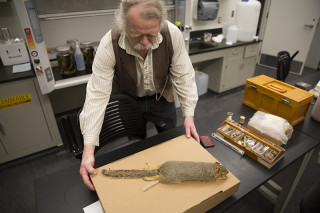Urban Mammals
In Northern Utah, it is not uncommon to see mammals in our cities and towns. Mammals like Raccoons, tree and ground squirrels, rabbits, deer, beavers, foxes, and coyotes, to name a few, have adapted to live in urban environments, in addition to their native habitat.
Let’s Get Creative!
Draw a Fox Squirrel
The history of art and science are closely intertwined. Before the invention of photography and film, scientific inquiry required detailed drawings to record information. Drawing is also a great way to observe nature! In this video, learn how to draw a Fox Squirrel, a mammal we see frequently in the urban environment, with the help of a NHMU exhibit developer!
Listed below are the ingredients you will need:
- Sketch pad or paper
- Sharpie pen or dark marker
- Pencil and eraser
- Colored pencils or crayons
Download Nature All Around Us coloring sheets in both English and Español!
Get Outside!

We might not always see mammals, but they often leave clues behind for us to find! Let’s explore a few common ways you can identify different mammals, without ever seeing them!
-
Wild animal poop, known as scat, can be a great way to discover animals living nearby. Be sure to notice the scat’s shape and size. You can examine scat for clues about what an animal has been eating, but don’t touch it, as it can contain harmful bacteria. Here is a fun activity from the North Carolina Museum of Natural Sciences that makes scat “hands-on” at home.
-
Who’s been walking here? For centuries humans have studied and observed the unique tracks left behind by animals in dirt, mud or snow. As you walk outside, even right by your home, look around for tracks of urban mammals.
-
Did you hear that? The Western Soundscape Archive is an online record of hundreds of animal sounds recorded by citizen science volunteers that you can listen to from home! The archive includes sounds of more than 100 different types of mammals living in the west.
Connect with Local Experts
Learn more about Eastern Fox Squirrels, and why NHMU is studying them.
NHMU researchers are interested in the Fox Squirrel, a species not-native to Utah that is expanding its range in northern portions of the state. We need your help to learn more about them! Here’s how you can get involved:
- Help record where squirrels live: Add photos of any Utah squirrel you see to iNaturalist to give researchers a better idea of the spread of Fox Squirrels
- Observe squirrels, and let us know what you saw: To get more data on squirrel behaviors, we are depending on citizen scientists, like you, to send in information about squirrels.

Ask an Expert
Dr. Eric Rickart, NHMU's vertebrate zoology curator, hosted a live discussion on Facebook to answer squirrel questions. Follow the link below to watch the recorded discussion.
Explore More
Wasatch Wildlife Watch documents how wildlife moves across landscapes along Utah’s Wasatch Front. With the help of Citizen Science volunteers WWW has installed more than 200 motion-sensing cameras to photograph animals moving throughout the Central Wasatch Range. Check out more about the project with this video, featured in NHMU’s Nature All Around Us exhibit!
Though we may imagine Rocky Mountain Elk and Mule Deer high in the mountains far away from civilization, they often frequent urban areas and neighborhoods throughout Utah. Wildlife Photographer and National Geographic Photography Fellow Joe Riis has worked to document wildlife migrations for the past decade, and his work was featured at NHMU in 2019.